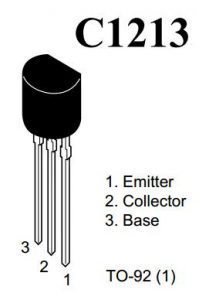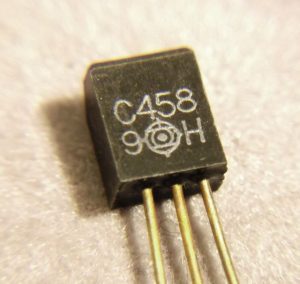Here’s something to be aware of… We’ve known that a number of Akai reel to reel tape decks suffer from bad 2SC458 transistors, and up until recently, we thought that only Akai decks were affected.
For those that are not aware, Hitachi made a transistor with the 2SC458 part number. Depending on the Akai model, they were used in various circuits, usually in the play and/or record circuit, and in the case of the later higher end models such as the GX635, they were found in the forward and reverse play and record circuits. The transistor is a low voltage preamplifier transistor, and is found in the head and mic/line amplifier sections.
The transistor is a bit unique in that it is a modified TO-92 transistor package where the Hitachi part number is stamped on the reverse side of the transistor as compared to other TO-92 transistors
A standard TO-92 package is flat on one side, and rounded on the other, and looking at the transistor from the front, left to right, the pinout is Emitter, Collector, Base, or ECB, which is standard for many small transistors made in Japan.

The Hitachi transistors are flat on both sides, and with the transistor ID stamped on the back of the transistor, the pinout as looking from the front is reversed from that of a standard TO-92 Japanese transistor. Left to right, the pinout is Base, Collector, Emitter, or BCE

The theory is that the wire leads of the Hitachi transistor get corroded over time, and that corrosion slowly creeps into the To-92 package, where it corrodes the silicone substrate of the transistor. This can lead to intermittent audio, distorted audio, or high background noise levels. On occasion, an audio channel can go completely dead, but left off overnight, the channel can start working again the next day. Even more annoying, if you pull the transistors out of the tape deck, they test just fine in a transistor tester. If you put a voltmeter on the transistor, then the readings are a mile off from what they should be, so our theory is that the transistor junction breaks down when an operating voltage is applied to it, but under the lower voltage of a transistor tester, they check OK.
Recently, we had a Teac 3340 in for repair, with distorted audio on channel 2 on playback and record modes. Normally the Teac 3340 electronics are very reliable, and we’d never seen a fault like this before. Upon inspection, we found that same Hitachi transistor package in the Teac 3340, but in this case the transistors were 2SC 1345. Each play and record channel had one 2SC 1345 transistor in the circuit, for a total of 8 transistors. We changed only the one transistor in channel 2, an found audio to come back to normal. We left the deck on our bench, turned on for 48 hours.
Within 24 hours, we had excessive background noise in record mode only on channel 4. We traced that to another bad 2SC 1345 transistor on the record board of channel 4. Once we changed all 8 transistors on the play and record boards, the deck ran solid for a week before we sold it.
We’ve spoken with other technicians, and have confirmed that other transistor numbers, also the unique transistor package, all made by Hitachi, have gone bad in the past. We are therefore now changing every one of these Hitachi transistors out on every reel to reel that comes in for service.
If you know how to solder, then you can order these transistors from numerous reputable suppliers online, in a standard TO-92 transistor package that does not have the Hitachi logo on it, as shown in the above and below photos.

Remember to put the replacement TO-92 transistors in backwards compared to the Hitachi ones, with the transistor number facing the opposite way, otherwise the circuit will not work.
Any number of Akai decks use the 2SC458 transistors, right back to the entry level 4000 models. By the time Akai made the last and top of the line GX-747 model, they had stopped using the 2SC 458.
We only know of the Teac A-3340 models using the 2SC 1345 transistor designation, but we’re pretty certain that other Teac decks use them as well. If you want to confirm, check the service manual of your particular machine to see if it uses that same transistor number. As we find other makes and models of decks, we will add to the list of affected decks.
Akai:
4000 series of 7” machines
GX-215
GX-600
GX-635
GX-636
Teac:
A-3340(s)

